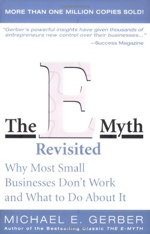"The E-Myth Revisited" Book Writeup
June 03, 2014
 The E-Myth Revisited: Why most small businesses don't work and what to do about it
Michael Gerber
ISBN: 0887307280
The E-Myth Revisited: Why most small businesses don't work and what to do about it
Michael Gerber
ISBN: 0887307280
What’s the point?
The E-Myth — short for The Entrepreneur Myth — is that only by some epic, odds-defying
effort can a visionary entrepreneur create a successful business. The book goes through it’s
own brand of trademarked business process based on creating a turn-key, franchise (whether or not
you intend to franchise it is a moot point).
I read this book on recommendation from the Giant Robots podcast, mainly on the basis of the intriguing review of this book as the “worst/best business book ever”.
How was it?
I get why this is the one of the worst and best business books simultaneously! There is a lot
of empty substance that I didn’t find practical (at least to my domain of software and engineering
services); the long monologue style was off-putting and at my times my Bozo Detector was
going off the charts.
The basic thesis is that to have a successful small business you must follow the patterns of turn-key franchise operations — otherwise you will always be “trapped” working in your business, not on your business. If you can’t take a day off without your business having to close, you are really just an employee, not a business owner.
But there are also some really interesting nuggets of wisdom. And since people only really remember the nuggets of wisdom in these kind of business books anyways, there is value in reading this book.
The two most impactful points were the concepts of a “technician mindset” and “replacing yourself in the org chart”.
When technical/skilled workers branch out on their own, they often have a false vision that running their own company means they will be able to do all the same things they did while working for someone else, but without a boss! I like programming, so if I start my own software consultancy, I can program all day on stuff I want to do and not have some suit telling me what to do! Wrong.
The other two facets (the entrepreneur mindset and the manager mindset) need to be balanced. If you spend all day coding (technician) but don’t spend any time on brainstorming new engagement models (entrepreneur) or handling invoicing (manager), you are going to end up stressed out and over-worked. Finding the right balance is difficult and a struggle in personal confidence, but I found that acknowledging what mindsets are out of your comfort zone to be useful.
The author advocates that one of the first activities your business should do is to come up with the org chart for your company five years in the future. It seems silly to list managers and presidents and departments when you have a one or two person company, but the idea is to fill each role with yourself. This helps you visualize exactly how many hats you have to wear early on and emphasizes that you need to come up with a system for each role so that you can fill it with someone else. The idea is to work in the lowest ranking jobs first, document your best-practices, and then hire someone to follow your guide while you start working the next position up (repeating the process until you can remove yourself completely).
Who should read it?
I found the concept of a turn-key franchise business to be interesting and that the technician
mindset would be a trap that I might fall into had I not been exposed to this book. I found
the “replace yourself in the org chart” model to be very pragmatic, even in a traditional
corporate environment; I find that we can often find motivation to start a new initiative, but
we don’t plan for how to eventually transition the responsibilities and workload once the initial
enthusiasm dies down.
